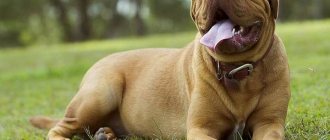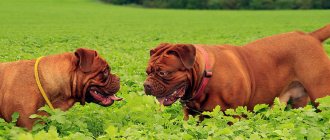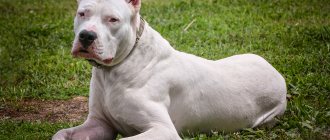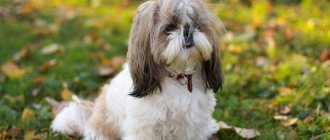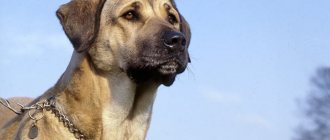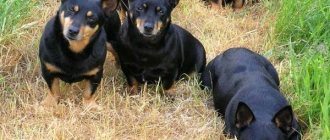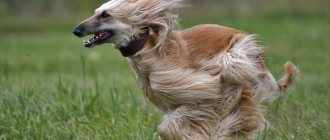Dogue de Bordeaux: photo, character
There can be no consensus here because some dogs are kind, others are evil. In principle, this is observed in any breed. According to the available description, most representatives of the Dogue de Bordeaux breed have a calm character . And when they appear in the house, they do not try to try on the status of a king. They do not single out the only one among family members to whom they will unquestioningly obey. Therefore, all household members are equal before him. And in order for an evil creature to grow from a Dogue de Bordeaux, you will have to try hard.
It is necessary to consciously purchase a Dogue de Bordeaux puppy, and for this you need to know for what purpose you need the dog. Therefore, the first thing you need to do is talk to the breeder, because he will probably tell you which puppy is best for you. He is well aware of the character traits of each of his pets.
Of course, it is best to purchase a Dogue de Bordeaux dog from a kennel. But after the choice is made, you should not immediately go home with him and enjoy his company. Be sure to ask the breeder for contact information and contact him as needed . Breeders know a lot about these animals, so they can give you valuable advice on what to do in a certain situation. And do not think that you are able to raise a dog of this breed using your own methods, which you have probably heard well about.
The Dogue de Bordeaux needs a lot of space and does not tolerate restrictions in movement. Therefore , it is best if you keep it in a summer cottage or in a country house . There will be no rules for him there and therefore he will be able to run wherever he wants. An apartment is not suitable for such a freedom-loving animal.
Please note that the Dogue de Bordeaux is not a street dog, so you cannot leave it in an enclosure or kennel, especially in winter. In the house you need to allocate a place for it as far as possible from your bed or bedroom . Otherwise, you will create great inconvenience for yourself, since these cute animals snore during sleep. So if you want to have a peaceful night, you should take soundproofing measures.
Dogue de Bordeaux: care and feeding
Until your Dogue de Bordeaux puppy is 5-6 months old, don’t even think about training him or increasing his physical activity. The level of activity should be determined by the puppy himself : if he decides to sleep, then you should not disturb him. If he still has the strength to play, then keep him company.
Although dogs of this breed have short hair, it is still necessary to pay attention to it. First of all, you need to regularly carry out such mandatory procedures as bathing and combing . A distinctive feature of all Bordeaux dogs is the presence of many folds on the muzzle. If you do not keep them clean, then along with the dirt, various infections will get on your pet, and this is a risk of developing dangerous diseases.
Dogues de Bordeaux have a fairly powerful body, and they have to expend a lot of energy. Because of this, you should not overload them. Therefore, you need to play outdoor games with an adult dog of this breed for no more than one hour . If you have a puppy growing in your apartment, then this time needs to be reduced even more. If you have an older Great Dane, do not overload him with games, as one walk is enough for him.
The appearance of the Dogue de Bordeaux clearly indicates that its diet certainly should not consist of only fruits and vegetables. All dogs are carnivores, so Bordeaux must be fed meat, which should form the basis of their diet. Your pet's menu should also foods containing essential vitamins and sea fish. We draw your attention to the fact that it must be sea, not river. Giving the latter to dogs is strictly prohibited.
You should regularly add calcium, fish oil, vegetables and fruits to your dog's food. The Great Dane's favorite treats are milk and other dairy products. The Bordeaux puppy especially needs them. In order for the puppy to grow and develop well from the first days, you must feed him the same products as the breeder.
New foods must be introduced into your dog's diet gradually, otherwise it may cause stomach upset.
- Until the puppy is 4 months old, he needs to be given 100 grams of raw meat every day.
- From six months to one and a half years, the daily portion of meat should be 800 grams.
- Upon reaching the age of 1.5 years, the serving size is reduced to 500–600 grams of meat per day.
Moreover, the meat should not be given as a whole piece, but finely chopped. Experts recommend feeding Dogue de Bordeaux beef . It is not recommended to give him pork and lamb in any form.
In addition to the above products, the menu of a dog of this breed must include bones and cartilage. However, do not try to give him tubular bones , since when they are eaten, sharp fragments are formed that can injure the walls of the animal’s stomach and intestines. This poses a serious threat to the life of the animal, which may even die.
In principle, you should not consider bones as the main product of the Dogue de Bordeaux diet. Treat it like a treat. If a dog eats bones frequently and in large quantities , it may become constipated. Also included in the list of prohibited foods are flour products and potatoes. Eating these foods frequently increases your dog's risk of intestinal upset.
Health
Nature has blessed Dogues de Bordeaux with good health, but, unfortunately, they cannot be called long-livers. On average, Bordeaux can live 8-10 years. In order for a dog of this breed to live as long as possible, the owner must monitor his health, get vaccinations, preventive examinations, and treatment for parasites on time. It is also important to familiarize yourself with the diseases to which the specified breed is predisposed:
• Difficult birth – Dogue de Bordeaux puppies are born with large heads, which is why the birth process in many cases is difficult, even leading to a caesarean section. • Dysplasia – accompanied by unbearable pain, lameness, and at the last stage of the disease there may be immobility. • Oncological diseases . • Cardiovascular diseases . • Hyperkeratosis is a pathology that occurs when the body begins to produce too much keratin. • Epilepsy – characterized by convulsions and involuntary bowel movements. • Entropion – can only be helped by surgery.
It is worth noting that Dogues de Bordeaux react poorly to temperature changes and climate change.
Dogue de Bordeaux training
Let us repeat once again that the Dogue de Bordeaux maintains a calm attitude throughout its life, so if you decide to yell at it or make a sudden movement in its direction, it will not react in any way. These dogs have guard skills from birth , so with proper training, you can quite easily raise him to be a guard at home or for family members. But you need to start training a puppy with the simplest thing - he must learn to distinguish his friends from strangers, and the commands “stranger”, “us” and “place” can help him with this.
Pros and cons of Dogue de Bordeaux
Future Great Dane owners will be interested to learn, first of all, about the positive aspects of this breed.
- Excellent security guard;
- Gets along well with family members;
- Companion dog;
- Easy to train;
- Nice looking.
But the first impression of these animals can be spoiled by their shortcomings:
- They eat a lot;
- Snore at night;
- Puppies are quite expensive;
- Sedentary.
Recommendations
Before you get yourself a Dogue de Bordeaux, evaluate the wisdom of this decision. And in order to make it easier for you to decide whether you are doing the right thing or not, we recommend that you go to forums dedicated to the Great Dane , where you can read reviews from owners and also watch videos. It is possible that after reading the information presented there you will lose the desire to get a dog of this breed. Therefore, it is better to reinforce your confidence that you are doing the right thing, otherwise you will harm not only yourself, but also the animal.
If even after this you still have the desire to purchase a Dogue de Bordeaux puppy, we advise you to contact kennels that specialize in breeding Dogue de Bordeaux. This option is good because it can provide you with complete information about both the puppy itself and its parents and breed. Private owners will not be able to offer you the same large selection of puppies that nurseries have. However, in terms of price, they, of course, lose to private sellers.
You can buy a Dogue de Bordeaux puppy for a price ranging from $150 to $3,000. It is clear that you need to take a large amount of money with you when you go to a kennel to pick up a puppy. You, of course, can turn to a private owner and save a lot, but he will not be able to provide you with as many options as a nursery.
The Dogue de Bordeaux is a fairly ancient breed, which confirms its vitality and durability. You can consider it not only as an ordinary pet , but also as a gift for children. But keep in mind that it must be constantly monitored, otherwise your children may injure the puppy while playing.
Keeping a dog in an urban environment is quite simple. The main thing is to remember that meat should always be present in his diet. Therefore, your budget should always include an amount for these expenses. By themselves, Dogues de Bordeaux do not show much aggression , however, sometimes you come across quite vicious individuals with whom nothing can be done. But if you walk in places where there are few people and other dogs, you can avoid a lot of trouble. But, having decided to get a Dogue de Bordeaux, you will see what excellent guards and companions they are.
How to choose a puppy
When planning to get a charming four-legged friend, decide on its class. Dogs in the “show” category can win the show because they best meet the breed standard. For animals of the breed class, minor deviations are allowed, but this does not prevent the dogs from being used for breeding. Dogues de Bordeaux of the pet class are typical pets, whose non-compliance with the standard does not allow participation in exhibitions or breeding programs.
The next stage is the sex of the animal. Bitches are more obedient, but they are not lacking in cunning and feminine cunning. Males are quarrelsome and independent, so you will have to show remarkable strength of character in dealing with them.
Now you can start looking for a trusted nursery. Before meeting the babies, ask the breeder to introduce you to their parents. Pay attention to possible defects: they can be inherited by puppies. It is equally important to check the necessary documentation: veterinary passport, pedigree diploma, test results for dysplasia. Only after this can you go to meet your future friend.
A healthy puppy is moderately playful and curious. The animal should not limp, whine for no reason, hide cowardly, show lethargy or excessive excitement. Carefully examine the baby and finally check the brand and nickname with his passport. Now you can start concluding a deal with the breeder.
Description and photo
The description of the Dogue de Bordeaux breed represents the characteristics according to the standard and indicates the characteristic features of the animal. By the way, the spelling of the name of the breed “Bordeaux” with two “ss” is outdated, the modern form is with one.
Breed standard
The breed standard is quite strict; it includes everything from color to appearance.
Country of origin: France.
Standard recognition: CKC, FCI, AKC, ANKC, NKC, NZKC, APRI, ACR.
Life expectancy: 10-14 years.
Litter: 9-12 puppies.
Height: depends on the gender of the dog. Male - at the withers up to 65-68 cm, female - 55-65 cm.
Weight: at least 45-50 kg. Some large individuals can reach a weight of 90 kg.
Coat: very short, smooth, soft. Shedding is moderate.
Head: large, with a wide flat forehead, on a short neck. Covered with many folds. May have a black or dark brown mask.
Lips: very saggy.
Eyes: oval, widely spaced, with overhanging folds of skin.
Ears: Drop but elastic, with rounded tips.
Nose: rounded, wide.
Body: large, muscular, slightly disproportionate, squat, covered with folds of skin. A slight lifting of the pelvis is allowed. Wide chest.
Tail: Elastic, short, without white spots.
Features of maintenance: can be kept in an apartment with proper care. The best content is in a house with a large yard.
Great Dane character
The description of the Dogue de Bordeaux breed, or French mastiff, also includes a description of the dog’s qualities.
The character of the breed is calm, balanced, one might even say intelligent. This is both a companion dog and a nanny dog. Although this breed is watchdog, Bordeaux does not show any aggression.
It can protect the house simply through its intimidating appearance and frightening size. Despite his angry appearance, the dog is actually very kind.
Gets along well with all family members, especially children. Bordos does not like outdoor games, but will play with children with pleasure.
Can make friends with other pets if it is introduced to them from an early age. Keeping with breeds of similar or larger size is not permitted. Aggression on his part is possible.
May be offended if punished undeservedly. But since he loves his owner very much, the resentment passes quickly.
The Dogue de Bordeaux dog is very sociable. Not suitable for an owner who is away all day. He will be very bored and may even act out.
The breed is highly intelligent, but it is not necessary to train (in the sense of “drive”). He can only tolerate moderate physical activity, as he gets tired quickly.
The dog cannot be called playful and active. At an early age, playing for more than an hour a day is even contraindicated.
Attitude towards children and pets
The Dogue de Bordeaux is tolerant of all family members. He is very tolerant and gets along well with children. However, you should not leave the Dogue de Bordeaux alone with the child. Still, the dog is large and can inadvertently push the child.
The Dogue de Bordeaux gets along well with other pets . Problems may arise if two males collide. He will not tolerate pranks and bullying from other dogs and will get into a fight.
Selection and cost of a puppy
The choice of a puppy must be approached with special responsibility. First of all, ask the owner for information about the health status of the parents. A certificate from a veterinarian with a recent date will not work.
Find out the details: hereditary diseases, allergic reactions, drug tolerance, vaccinations, moving. Remember that heredity can appear at any time.
Before you buy Bordeaux, monitor the situation. The animal loves attention and does not tolerate loneliness. If you don’t have enough time to take care of him and your dog will have to be bored alone for a long time, then it’s better not to buy it.
The price difference is big: from $150 to $3000. If you buy it second hand, it’s cheaper; if you buy it from a nursery, it’s more expensive. Compliance with the standard, color, order in documents, etc. are important.
If you are going to show your dog at shows, then do your due diligence on the breeder. If you need a pet, choose according to your heart.
It is better to purchase Bordeaux breeds that meet the standard from an officially registered nursery.
Suitable age for purchase is from 8-10 weeks and older. Take the puppy from home to personally inspect the living conditions and meet the parents. Because healthy, well-groomed parents will most likely have healthy children.
When choosing a puppy, pay attention to the head, legs, tail, color, presence and location of white spots. However, the most important thing is his health. A healthy baby has a well-groomed appearance, a dense body without a big belly. The skin on the abdomen is without rash, pink.
Examine your pet's ears, nose, and eyes. There should be no scratching, no discharge, and especially no smell. Under the tail should be clean, without traces of feces and fur matted from diarrhea.
Be sure to look into the mouth: make sure it has a natural color, without wounds or inflammation. Review certificates of vaccinations and deworming.
Watch puppies outside. When they play, it is easy to see the baby's character. Choose which one suits you.
Reproduction and lifespan
These powerful dogs serve from 8 to 11 years. The healthier the dog, the longer he lives. Therefore, always monitor your pet’s health. Remember that only hardy, mentally stable and strong mastiffs that meet the breed standard are allowed to breed.
The first heat in female dogs occurs between 9 and 12 months. But at this stage it is impossible to bring her together with a male Great Dane. The young dog cannot bear and will not give birth to healthy puppies. Therefore, a female over 2 years old should be used for breeding. She must show sexual interest in the male and not push him away.
As for the male, he reaches the age of sexual maturity much earlier, at about 4 months of age. But, in his case, the rule for mating is similar. The breeder must select a high-breed male over 2-2.5 years old.
Where to keep a pet
The French Mastiff can be kept both in an apartment and in a private house. If you live in an apartment, the dog will need two walks a day (no more than 1 hour).
Be sure to provide a designated place for your dog with a bed. Food must also be in a certain place. There should be a leash for walking in the same place.
It is better, of course, to keep a dog in a private house with a large yard. The dog can live indoors, but walks in the spacious yard will only benefit him. After all, in a fenced area the dog will be able to walk and relax without restrictions.
How to care for the breed
Caring for a French Mastiff is easy. It includes grooming, bathing, preventative measures for teeth, ears, eyes and paws, a certain level of exercise and, of course, proper nutrition.
Grooming
Bordeaux's coat is very short and shedding is moderate. There is no need to comb the dog. It will be enough to periodically, at least once a week, walk through the wool with a rubber glove purchased at a specialized store.
This will remove loose hair and dead skin cells. After this procedure, the coat becomes shiny and the dog looks well-groomed. Such a massage will only benefit her.
You can bathe your dog less often: when dirty or twice a month. After a walk in hot weather, you can give her a cool shower for 10-15 minutes.
What is really important is treating and washing the skin folds after walking. After all, there may be dust and dirt in the folds, which can cause inflammation or irritation of the skin.
This is especially true for folds on the muzzle. After all, even particles of food can settle there, which will cause an unpleasant odor from the dog.
Paws should be washed after every walk. After washing, wipe the pads with vegetable oil. This way you can avoid drying and roughening the skin.
Examination of eyes, paws, ears, teeth
The Dogue de Bordeaux may have sour eyes. You need to monitor this carefully, inspecting it daily. If it gets sour, wipe it with a cotton pad with warm boiled water, or you can use tea without sugar.
The ears also need to be examined frequently. There should be no redness, inflammation, large amounts of sulfur, or unpleasant odor. If any of the symptoms appear, contact your veterinarian. Never treat a dog yourself.
When washing your paws after walks, you need to inspect them for cracks and damage. Every two weeks, the claws are trimmed with a special nail cutter, and the sharp edges are filed down with a file.
The dog’s teeth also require care, from which plaque must be removed, and if overlooked, then tartar. You need to brush your teeth regularly, using a special brush and toothpaste. Only a veterinarian can remove tartar.
Also, puppies need to monitor their oral cavity while changing teeth. The subject of the examination is the correctness of the bite, the remains of baby teeth, the health of new teeth.
Load and activity
The French Mastiff is a rather phlegmatic dog that does not like running, active games, or long training sessions. And they are not shown to her by breed.
Puppies, of course, can actively play, but they should not be overloaded, as this can lead to disturbances in bone development, posture, and skeletal formation in general. Exercise is especially harmful for puppies after eating.
A mature dog needs walking for an hour twice a day. That's enough for her. When running fast, the dog may experience shortness of breath, hoarse breathing, and rapid heartbeat. It's bad for her.
What to feed
Nutrition is one of the most important components in keeping any dog. It should be balanced and nutritious.
Bordeaux, first of all, needs meat products. In order for the dog to receive a sufficient amount of vitamins and minerals, the diet must include fruits, vegetables, and sea fish.
Before picking up a purchased puppy from a breeder or kennel, you need to know its diet. A sudden change in diet is harmful to the dog and may be accompanied by indigestion.
You can feed puppies with special ready-made food “For puppies”, always premium. If the food is natural, then the puppy’s diet will largely consist of dairy products. From three months - fermented milk.
The best meat for a mastiff is beef (not veal). A mandatory addition is by-products. Cartilage and bones are not only a delicacy for the Dogue de Bordeaux, but also a necessity.
They are rich in calcium and are needed for the proper development of the skeleton, joints and teeth. A dietary supplement for puppies would be fish oil. Access to clean water must be constant.
A dog's diet at a young age should include raw or cooked fruits and vegetables.
Adult dog
An adult dog is fed the same as a puppy, only a few foods are added. So, the menu: in the first place, naturally, is meat, then - offal, fish (sea fish only), fermented milk (cottage cheese, kefir), vegetables and fruits.
Education and training
Education and training of French Mastiffs is more of an education process. Representatives of the breed acquire various skills easily and quickly because they have a high level of intelligence.
The dog needs to be accustomed to a place of rest and food, learn the basic commands with it: “place”, “near”, “no”, etc. Next, it needs to be socialized: taught not to be afraid of cars, large numbers of people, or meetings with other animals.
In this process, the owner must be patient and attentive. Forcing a mastiff to carry a stick or run after a ball is inappropriate, because such active actions are not for this breed.
Application
According to the current 1995 breed standard, the purpose of the French Mastiff is protection, guarding and intimidation. In this they are not inferior to fighting dogs .
Bordeaux dogs can be intimidating with their appearance alone; they do an excellent job of protecting a house or apartment, but they are categorically unsuitable for enclosure keeping.
These dogs show themselves best as companions: they are very human-oriented, always ready to accompany their owner on leisurely walks; in difficult times, a Bordeaux dog will sit next to you and sigh sympathetically - and this is the best psychotherapy in the world.
Typical diseases and difficulties of care
The Dogue de Bordeaux, like other breeds, is susceptible to certain diseases. There are also difficulties in care.
There are five most common problems with Bordeaux:
- pelvic joint dysplasia;
- allergy;
- difficult birth (due to the large head of the fetus);
- oncological diseases;
- hereditary predisposition to heart disease.
Required vaccinations
Disease prevention is the key to animal health. Preventive vaccinations for Bordeaux are simply necessary.
At the right time, puppies and adults are vaccinated against parvovirus enteritis, viral hepatitis, distemper and rabies. The vaccination schedule will be drawn up by a doctor.
So, if you want to have a calm, balanced, intelligent dog, then your choice may fall on a French mastiff or Dogue de Bordeaux (as you like). This breed is especially suitable for homes with small children. Bordos is an irreplaceable nanny.
History of the breed
Bordeaux are considered descendants of Molossian dogs. Mixed breeds of Molossians and big-breasted greyhounds were called Alans; later dogs of heavy breeds were given the name votre.
Today they are classified as mastiffs (Mastiffs), meaning strong dogs whose purpose is baiting and protection. Some authors are confident that Bordeaux are direct descendants of the Dogues of Aquitaine , one of the Gallic provinces (France). The administrative center of modern Aquitaine is the city of Bordeaux. This region is surrounded by the Pyrenees, which contributed to the isolation and preservation of the purebred French Mastiffs.
The number of dogs decreased after the French Revolution of 1789 - they were killed along with their rich owners, considered a symbol of luxury. Some of the Dogues de Bordeaux were taken abroad, the rest were mixed with individuals of other breeds.
By the end of the 19th century, this breed had become rare in France. Some researchers claim that purebred Bordeaux are preserved only in the Pyrenees, near the Spanish border. were used for fighting in Southern France . Perhaps this contributed to the preservation of the breed.
Butchers used French mastiffs as draft animals , harnessing them to carts to transport meat carcasses. At the same time, dogs were involved in security functions . Untrained dogs exhibited wild temperaments, gaining a reputation for being vicious and bloodthirsty. The police have ordered dog owners to wear muzzles or tie them tightly.
The breed gained popularity in 1863, when a Great Dane from Bordeaux named Magente won the first Parisian dog show and received a gold medal. Gradually, Bordeaux became known throughout the world. The first representatives of the breed came to Russia in 1990. Later, the national club “Dogue de Bordeaux” appeared.
